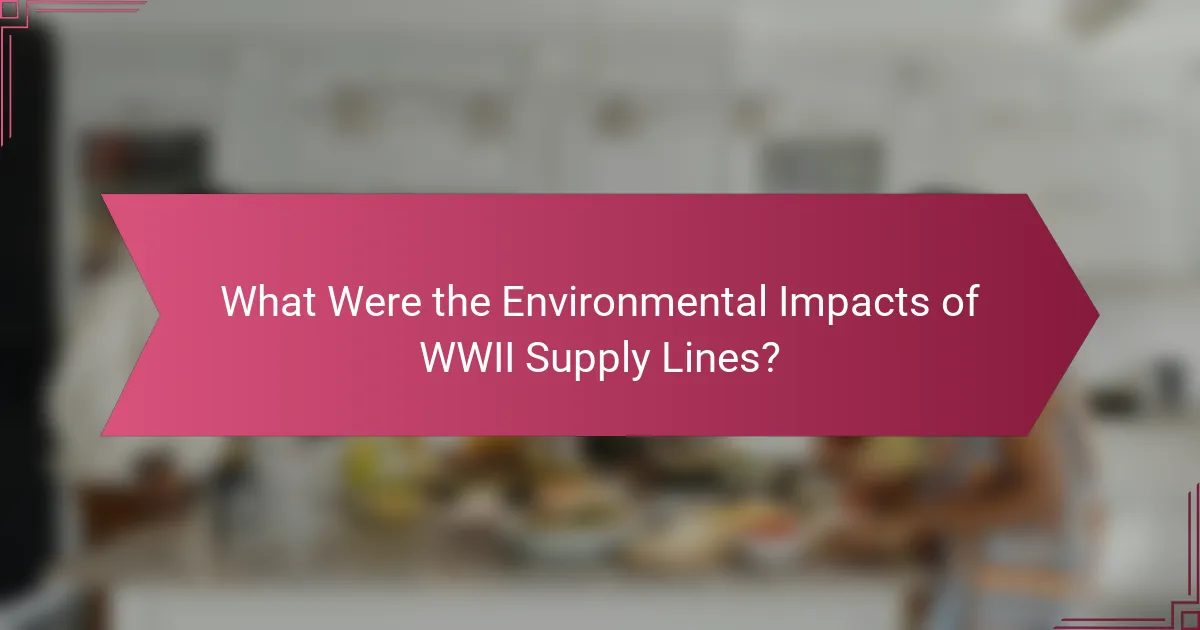Supply lines played a vital role in the success of military operations during World War II, directly impacting logistics, strategy, and campaign effectiveness. The establishment of sustainable supply chains, which utilized local resources and optimized transportation networks, was essential for ensuring that troops received the necessary resources to maintain operational momentum and achieve victory.

How Did Supply Lines Impact WWII Campaigns?
Supply lines were crucial to the success of military operations during World War II, affecting logistics, strategy, and overall campaign effectiveness. A well-established supply chain ensured that troops received necessary resources, thereby influencing the outcomes of battles and the speed of troop movements.
Critical for logistics
Effective supply lines were the backbone of military logistics in WWII, ensuring that food, ammunition, and equipment reached front-line troops. The complexity of these supply chains required careful planning and management, often involving multiple modes of transportation, including trucks, trains, and ships.
For instance, the Allies utilized the extensive rail networks in Europe to transport supplies rapidly, while the Axis powers faced challenges due to longer supply routes and less developed infrastructure. This disparity often dictated the pace and success of military operations.
Influenced battle outcomes
The availability and reliability of supply lines directly influenced the outcomes of key battles during WWII. For example, during the Battle of Stalingrad, the Soviet Union’s ability to cut off German supply lines was pivotal in turning the tide against the Axis forces.
Conversely, the failure to secure adequate supplies led to significant defeats, such as the German retreat from Moscow in 1941. Commanders had to prioritize securing supply routes to maintain their operational capabilities.
Enabled rapid troop movements
Well-maintained supply lines allowed for rapid troop movements, which were essential for strategic maneuvers. The ability to quickly move soldiers and equipment to critical locations often determined the success of military operations.
For example, the D-Day invasion relied on a robust supply chain to support the rapid deployment of Allied forces in Normandy. This logistical success enabled the Allies to establish a foothold in Europe and push back against Axis powers effectively.

What Strategies Were Employed for Sustainable Supply Lines?
During World War II, sustainable supply lines were crucial for maintaining military operations. Strategies focused on utilizing local resources, optimizing transportation networks, and implementing strategic stockpiling to ensure efficiency and resilience.
Use of local resources
Leveraging local resources was a key strategy for sustaining supply lines during WWII. By sourcing materials and supplies from nearby areas, armies reduced transportation time and costs, while also minimizing the risk of supply disruptions. For instance, the use of local agricultural products helped feed troops without relying heavily on distant supply chains.
Additionally, local industries were often mobilized to produce essential goods, such as ammunition and vehicles, which further supported military efforts. This approach not only enhanced sustainability but also fostered local economies.
Efficient transportation networks
Efficient transportation networks were vital for the timely delivery of supplies. Railroads, roads, and waterways were optimized to facilitate quick movement of goods to the front lines. In many cases, military planners prioritized the development of infrastructure in strategic locations to enhance logistical capabilities.
For example, the establishment of dedicated supply routes and the use of convoy systems helped protect shipments from enemy attacks. This focus on efficiency ensured that troops received necessary supplies, such as food and ammunition, without significant delays.
Strategic stockpiling
Strategic stockpiling involved the accumulation of essential supplies at key locations to prepare for potential shortages. Military leaders identified critical resources, such as fuel, food, and medical supplies, and ensured they were stored in secure, accessible locations. This foresight allowed for sustained operations even during periods of intense conflict.
Effective stockpiling required careful planning and regular assessments of supply levels to avoid waste. By maintaining adequate reserves, armies could respond swiftly to changing battlefield conditions and maintain operational readiness.

What Role Did Technology Play in Supply Line Sustainability?
Technology significantly enhanced supply line sustainability during WWII by improving efficiency and reliability in logistics operations. Innovations in transportation, communication, and logistics management were crucial for maintaining the flow of resources and troops across various theaters of war.
Advancements in transportation
Transportation technology evolved rapidly during WWII, with the introduction of more efficient vehicles and aircraft. Trucks, trains, and ships were optimized for speed and capacity, enabling faster delivery of supplies to frontline troops.
For instance, the development of the Jeep and other military vehicles allowed for quick movement across diverse terrains, while cargo ships were designed to carry larger loads, reducing the number of trips needed. This efficiency was vital in ensuring that troops received necessary supplies in a timely manner.
Communication improvements
Effective communication was essential for coordinating supply lines, and advancements in this area had a profound impact on sustainability. Technologies such as radio and telegraph allowed for real-time updates on supply needs and logistics challenges.
These communication tools enabled commanders to make informed decisions quickly, ensuring that resources were allocated where they were most needed. The ability to relay information swiftly helped to minimize delays and prevent shortages in critical situations.
Logistics management tools
The integration of logistics management tools transformed how supply lines were organized and executed. Systems for tracking inventory and managing supplies became more sophisticated, allowing for better planning and resource allocation.
For example, the use of standardized shipping containers streamlined the loading and unloading process, reducing time spent in transit. Implementing these tools helped military planners anticipate needs and respond effectively to changing circumstances on the battlefield.

How Were Supply Lines Managed in Key Campaigns?
Supply lines during World War II were critical for sustaining military operations, ensuring troops received necessary resources like food, ammunition, and equipment. Effective management involved strategic planning, coordination, and adaptation to the challenges posed by geography and enemy actions.
North African Campaign
In the North African Campaign, supply lines were often stretched thin due to the vast desert terrain and the need for rapid movement. Both the Allies and Axis forces faced challenges in transporting supplies across long distances, which required careful planning and the establishment of supply depots.
Logistics included the use of ports like Alexandria and Tripoli, which were vital for receiving shipments. The Allies implemented a system of convoy escorts to protect supply ships from Axis submarines and aircraft, significantly impacting the campaign’s outcome.
Pacific Theater logistics
Logistics in the Pacific Theater presented unique challenges due to the vast ocean distances and numerous islands. Supply lines had to be flexible and responsive, often relying on aircraft carriers and amphibious assault ships to deliver supplies directly to forward positions.
Key strategies included establishing bases on captured islands, which served as staging points for further operations. The use of floating supply depots and pre-positioning supplies ahead of assaults were common practices to ensure troops had the necessary resources during critical battles.
European front strategies
On the European front, supply lines were managed through a combination of rail and road networks, which facilitated the movement of troops and materials across various countries. The Allies focused on securing key transportation hubs to streamline logistics and reduce the time needed for resupply.
Operations like the Red Ball Express were implemented to enhance supply flow to frontline units, utilizing trucks to move supplies quickly. The importance of air support for rapid resupply and the establishment of supply routes through liberated territories were also crucial for maintaining momentum in the campaign.

What Were the Environmental Impacts of WWII Supply Lines?
The environmental impacts of WWII supply lines were significant, affecting natural resources, air and water quality, and long-term ecological stability. The extensive logistics and military operations led to resource depletion, pollution, and lasting changes to ecosystems.
Resource depletion
WWII supply lines required vast amounts of raw materials, leading to significant resource depletion. Essential resources such as timber, metals, and oil were extracted at unprecedented rates to support military operations and production. This overexploitation often resulted in shortages that affected civilian industries and post-war recovery.
For example, the demand for rubber led to extensive deforestation in Southeast Asia, disrupting local ecosystems and communities. The extraction of these resources often ignored sustainable practices, causing long-term damage to the environment.
Pollution from military operations
Military operations during WWII generated substantial pollution, impacting air, soil, and water quality. The use of heavy machinery, vehicles, and munitions released harmful substances into the environment, including oil spills and chemical runoff. These pollutants not only harmed wildlife but also posed health risks to nearby populations.
Areas near battlefields and supply routes often experienced contamination from explosives and hazardous materials. For instance, the production and disposal of munitions led to toxic waste that lingered long after the war ended, complicating recovery efforts.
Long-term ecological effects
The ecological effects of WWII supply lines have been felt for decades, altering landscapes and biodiversity. Habitat destruction from resource extraction and military activities led to the decline of various species and disrupted ecological balance. Regions heavily impacted by war often struggle with recovery, as invasive species can take hold in disturbed environments.
In many cases, the scars of war remain visible, with some areas still grappling with the consequences of pollution and habitat loss. Restoration efforts are often hampered by the lingering effects of wartime activities, highlighting the need for careful management of natural resources in post-conflict settings.

What Lessons Can Be Learned for Modern Supply Chain Sustainability?
Modern supply chain sustainability can draw valuable lessons from World War II campaigns, particularly in terms of resource management and strategic planning. Key takeaways include the importance of flexibility, local sourcing, and the need for robust contingency plans to mitigate risks.
Importance of resilience
Resilience in supply chains refers to the ability to adapt and recover from disruptions. During WWII, supply lines faced constant threats from enemy actions, which necessitated quick adjustments and alternative routes. Modern supply chains must similarly prepare for unexpected events, such as natural disasters or geopolitical tensions.
To build resilience, companies should diversify their suppliers and logistics partners. Relying on a single source can create vulnerabilities; instead, having multiple options allows for quicker recovery in case of disruptions. Additionally, investing in technology for real-time monitoring can enhance responsiveness.
Practical steps include conducting regular risk assessments and developing contingency plans. Companies should identify critical components and establish backup suppliers or alternative transportation methods to ensure continuity. This proactive approach can significantly reduce the impact of unforeseen challenges.
